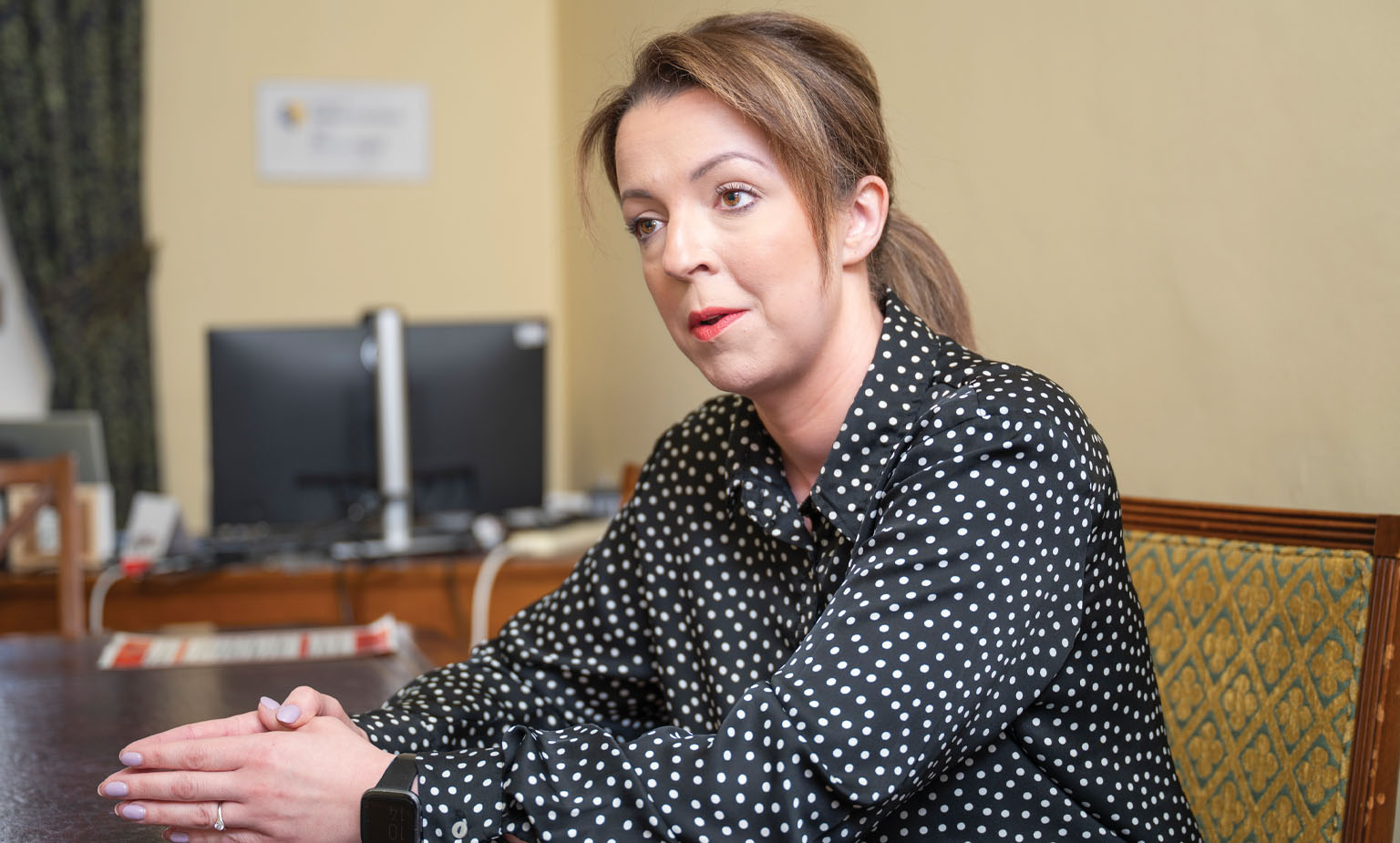Infrastructure Minister Liz Kimmins MLA: ‘Finance is a huge challenge’

In a spartan Stormont office, the walls still bare following her predecessor’s departure in Sinn Féin’s February 2025 ministerial reshuffle, newly-appointed Minister for Infrastructure Liz Kimmins MLA sits down with Ciarán Galway to discuss infrastructure delivery, wastewater policy, decarbonising transport, and cross border collaboration.
Remarking on the “huge brief” which her party has entrusted her to navigate, the Newry native emphasises that the Department for Infrastructure (DfI) is “critical to delivery through all other departments”.
Co-opted to replace Megan Fearon as a Sinn Féin MLA for Newry and Armagh in January 2020, Kimmins previously worked as a social worker in the South Eastern Health and Social Care Trust and was elected to represent the Newry DEA in the 2019 local council elections.
Discussing the prevailing challenges the Department faces, finance is foremost in the Minister’s mind, followed by “real legacy issues due to long-term underinvestment after 10 years of austerity”.
“We are now in a situation where that is critical, needs addressed and will impact our ability – and all other departments’ ability – to deliver, particularly in housing,” she observes.
Praising her predecessor and now Finance Minister John O’Dowd MLA, the Infrastructure Minister insists: “In his year in office since the Executive was restored in February 2024, John did a huge amount of work, and we have developed a strategy around seven foundations to outline what the priorities are for the Department.
“For me, it is about building on the work that has happened in his [O’Dowd’s] time and trying to see real delivery that will actually be tangible for ordinary people on the ground.
“It will be challenging, but I am up for that. We have to do the best we can with what we have.”
Specific successes
Asked to identify specific infrastructure successes since February 2024, the Minister naturally accentuates the opening of Belfast Grand Central Station in autumn 2024. “It has been a huge success,” Kimmins says, adding: “We have seen a 50 per cent increase in passenger numbers, which also ties in with my priorities – and previously John’s – to increase the use of public transport and try to enable a modal shift.”
“Finances will always be an issue, but we can still move ahead and make positive change…” Minister for Infrastructure Liz Kimmins MLA
Priorities
Outlining her current priorities for the infrastructure portfolio, Kimmins suggests that there are “three main things which really affect people”, namely wastewater infrastructure, planning, and roads.
With regard to the widely documented crisis relating to the inadequacy of existing wastewater infrastructure, which NI Water attributes to “historical underinvestment”, the Minister outlines that this priority entails: “Ensuring that we can deliver the change needed to build capacity, which will also unlock construction capacity for new homes and for other major projects.”
Describing planning as a “a huge issue and is something we are acutely aware of”, Kimmins says “a huge amount of work has gone into identifying where the difficulties lie”. This work, she says, is ongoing and seeks to identify bottlenecks to “try to address those”.
On roads policy, the Minister alludes to major schemes, reaffirming her commitment to the delivery of the A5 Western Corridor. Currently facing a High Court appeal, the planned project proposes to construct 55km of dual carriageway infrastructure between Strabane and Ballygawley, County Tyrone.
“The A5 is currently in court, but we hope to see a positive conclusion to that, and that we can push ahead because that will save lives,” the Minister asserts.
Delivery structures
In December 2019, the Northern Ireland Audit Office (NIAO) Major Capital Projects report endorsed the view that “current commissioning and delivery arrangements in Northern Ireland are not fit for purpose” and that “that there is significant merit in considering how alternative models, resourced with sufficient, highly skilled staff could improve future infrastructure delivery”.
Subsequently, in February 2024, the NIAO published Major Capital Projects: Follow-up Report concluding that the “public sector’s current portfolio of major capital projects will cost £2.45 billion more to complete than was originally estimated”.
Acknowledging “some limited progress”, the NIAO insisted: “There is little evidence of the substantial reform that is necessary.” While conceding that “major capital projects are inherently complex”, Dorinnia Carville, Comptroller and Auditor General, commented: “Even so, it remains extremely concerning that, more than four years after my office’s last report on this issue, there is little evidence of improvement or past lessons learned being applied to new projects.”
Asked to demonstrate what structural improvement – if any – has occurred in light of the NIAO’s conclusions, the Minister responds: “We are constantly reviewing some of the policies and mechanisms we have in place in the Department. Planning is one, and we are working on how we can improve that. Wastewater is another; I have recently launched a consultation on developer contributions which looks at different ways that we can bring extra funds into the Department which can then be translated into delivery for wastewater infrastructure.
“Another one is the Roads Maintenance Strategy. We recognise that our roads have only been getting a minimal service because of the lack of available funding. We need to explore the other options that are available to us and see how we can carry out road maintenance more efficiently and more effectively, but above all, make our roads more sustainable on a long-term basis.”
Advising that her officials are currently working on this, the Minister says that a paper will be “produced on this very soon” to “explore every aspect” of roads maintenance.
Programme for Government 2025
At the end of February 2025, the Executive agreed a programme for government for 2024-2027. In Our Plan: Doing What Matters Most the word ‘infrastructure’ is mentioned a total of 15 times, often in ambiguous terms, with timeframes, delivery metrics, budgets, and costs conspicuously absent.
Phrases such as “improving our infrastructure will be vital to delivering our priorities” and “our public infrastructure has deteriorated” leave much to the imagination.
Contextualising this “deterioration”, Kimmins is candid. “Finance is a huge challenge, but any minister could say the same. The scale of what we need to do through infrastructure is so vast that we are moving at a slower pace than we would like to be, but we have to be prepared for the scenario where additional funding is available, while continuing to examine alternative revenue streams and deliver within our means.”
Continuing, the PfG concedes: “We know that public investment alone is not enough and will continue to implement a planning improvement programme in collaboration with local government and other stakeholders.”
Responding to a question about better leveraging private capital, the Minister replies: “We are looking at all options available in seeking further investment. The Draft Investment Strategy Northern Ireland 2050 strategy is considering all of these things.
“Finance is a huge challenge, but any minister could say the same. The scale of what we need to do through infrastructure is so vast that we are moving at a slower pace than we would like to be, but we have to be prepared for the scenario where additional funding is available, while continuing to examine alternative revenue streams and deliver within our means.”
Wastewater policy
Currently, the Executive’s wastewater infrastructure policy is defined by three-prongs. These are:
- working with Executive colleagues to increase wastewater investment;
- exploring options for developer contributions; and
- introducing a Water, Flooding and Sustainable Drainage Bill to the Assembly.
Outlining that this policy was introduced by her predecessor, the Minister explains: “The first element of that was looking at working with Executive colleagues, which we have done. In John’s time, we have seen how that can be very successful.
“In October last year [2024], he was able to secure £19.5 million for NI Water which then unlocked capacity for over 2,000 homes being delivered. I think that is something that cannot be underestimated because that will make a huge difference to people’s lives and to communities.”
In March 2025, the Minister launched a public consultation on Developer Contributions for Wastewater Infrastructure. Seeking views on whether the Department should introduce developer contributions to help fund necessary improvements to wastewater infrastructure and how this might be pursued, the consultation remains open until 27 June 2025.
Discussing the potential inflationary impact on house prices if developers were to pass on the costs to homebuyers, the Minister emphasises the “huge costs” developers are already paying for connection to services.
“This is an opportunity to look at it in a more equitable way which will bring in a consistent funding which can be directly transferred into delivery on wastewater.
“There are a couple of options outlined in the paper, and I have been engaging with representatives in the construction industry too, such as builders, over the last eight weeks… I am under no illusion that this is the answer to all the challenges we face, but I think it is a part of the broader jigsaw, and it can help,” she asserts.
Anticipating the potential opportunities contained feedback in relation to the developer contributions consultation, Kimmins also commits to introducing a new Water, Flooding and Sustainable Drainage Bill to the Assembly to explore “natural drainage solutions”.
“Rainwater is the bulk of what comes through our system, so if we can treat that and deal with that in a different way, that will help to alleviate capacity in the infrastructure system. That will be coming through in the near future.”
“The scale of what we need to do through infrastructure is so vast that we are moving at a slower pace than we would like…”
Funding model
In March 2025, the Infrastructure Minister told the Assembly that, “the [NI Water] funding model that is in place is the best one”. Subsequently, the opposition has accused her of “refusing” to undertake an expert-led review of NI Water’s funding and governance model, as recommended by the NIAO.
In Funding Water Infrastructure in Northern Ireland, published in March 2024, the NIAO “encouraged” the Department for Infrastructure and NI Water to “complete a comprehensive review of the alternative funding and governance arrangements, led by suitably qualified experts”.
Rejecting the assertion that she opposes this move, the Minister clarifies: “What I have said is that the model currently in place is similar to that in the South and also in Scotland. In those places, it is working well; we have seen how funding models where there is an element of privatisation or mutualisation are not delivering.
“Water is something which I feel we all have an entitlement to, and I think that taking it out of government control could be challenging and create serious problems. We have seen how this has happened in both Wales and England.
“I believe that the funding model works well, but problem is that we have a shortage of funding. I do not believe that the answer lies in changing the funding model and creating a whole host of new problems in the process.”

Water charges
Addressing the Assembly in March 2025, the Minister also outlined her belief that “there is a concerted effort to push us in the direction to implement water charges”. Elaborating on this position, Kimmins insists: “The narrative around this continues to challenge the current funding model which I believe is the best funding model. Nobody has brought forward options other than those which will lead to water charges, whether that is direct or indirect.
“If someone brings something forward which is completely different, I am happy to consider that, but as it stands, the only options that have been presented to me by those challenging the current [NI Water] funding model are those which will implement water charges.”
Decarbonisation of transport
Enacted in June 2022, the Climate Change Act (Northern Ireland) 2022 established a target of net zero greenhouse gas (GHG) emissions by 2050. In meeting this objective, the decarbonisation of the surface transport sector will play an integral role. Today, however, transport remains the second largest source of energy-related emissions.
Asked to demonstrate specific examples of progress made towards decarbonising the sector since the Executive was restored in February 2024, the Minister emphasises her engagement with counterparts in the Republic and in Britain “in relation to the transition to electric vehicles”.
“We have seen some developments around helping people to transition away from petrol and diesel cars to electric vehicles. We also have a huge focus on active travel and public transport, especially with things like hydrogen buses and other things which are coming together.
“We still have a long way to go, but I think that, progressively, we are playing our part in achieving the targets in relation to climate change and decarbonisation,” she maintains.
Active travel
The Climate Act also set a 10 per cent minimum target for expenditure on active travel infrastructure as a proportion of overall transport budgets. In November 2024, the then-Infrastructure Minister launched a public consultation on the Active Travel Delivery Plan. The consultation closed at the end of February 2025.
Describing the significance of the Active Travel Delivery Plan – once finalised – Kimmins details the collaboration with local government where “a real effort is being made to improve travel routes and that is making it easier for people to engage in active travel”.
“That is happening through Safer Routes to Schools, connecting outskirts of towns and cities to the centres of their town and city, making it easier for people to walk or cycle. These are key projects.
“Lots of really good work has happened so far, and we just need to continue to build on that to normalise the option to use active travel and make it a real and viable option for people,” she says.
Asked whether she had ever utilised the objectively inadequate cycle infrastructure that exists Belfast, the Minister replies: “Not yet, but there are plans to get out on the bike.”
Irish Government capital investment
Given the enhanced role being played by the Irish Government in funding infrastructure projects in the North through its Shared Island Fund – including via the allocation of an additional €1 billion in March 2025 – Kimmins notes several concrete examples.
“The Irish Government invested £25 million into Grand Central Station, because that is an all-island project. It is the biggest integrated transport hub on this island and there are a lot of cross-border services associated with that.
“The Narrow Water Bridge is another aspect which is tied in with my own constituency [of Newry and Armagh]. But it is a really exciting project which will open connectivity but also create new economic opportunities on the east coast,” she outlines.
More broadly, the Minister reveals that officials in the Department for Infrastructure and their counterparts in the Department of Transport “have been working very closely”, while at ministerial level, “we have regular engagement”.
All-Island Strategic Rail Review
Turning to the All-Island Strategic Rail Review, the final report of which was published in July 2024, the Minister recounts her initial North South Ministerial Council transport sectorial meeting with Minister for Transport Darragh O’Brien TD in Dublin in February 2025. This, she says, was an opportunity to discuss the implementation of the review.
“I am realistic, and I realise that it is a long-term project with the amount of work required. But things like the electrification of the Dublin-Belfast line are real things that we will hopefully see delivered in the next five to 10 years.
“The feasibility studies for elements of that are due in the coming weeks. They will be concluding, and this will help to map out what comes next. It will then be about working with our counterparts in securing that investment to move on to the next stage.”
Ambition
Looking ahead to the remaining years of the Executive’s reduced 2022-2027 mandate, the Infrastructure Minister reiterates that the three key areas in which “we can make an impact” are wastewater, planning, and roads.
“I am very conscious that I have less than two years before the end of this mandate, so it is challenging, but I believe that these are the things which will have a tangible impact, and it will also feed into all of the other things that we are trying to do around road safety, public transport, and active travel.
“There are a lot of things which are interlinked, but if we can get good progress on those three key areas then that is something which I believe will be a good achievement,” she concludes.





